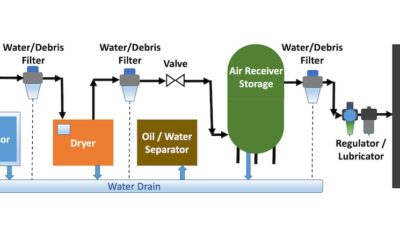New Technologies, New Applications

For the right industrial application – and there are many of them – a combined heat and power (CHP) engine system fueled with natural gas is an ideal package. The concept is simple. A rugged internal combustion engine turns an electric generator. Engine byproduct heat generates hot water. In this way, the fuel utilization is far more efficient than electricity and water heating fuel purchased separately.
CHP Being Viewed Positively
CHP (cogeneration) is increasingly viewed as a smart choice for industrial energy users, especially those who normally use significant amounts of hot water. Central-station thermal generation of electric power – whether it’s coal-fired, oil-fired, nuclear, gas turbines or engines – produces large quantities of waste heat. Normally, about two-thirds of the thermal energy produced is wasted. By moving the generation source close to the industrial or institutional energy user, that heat can be used for hot water heating, steam generation or process applications. It may even support a cooling system.
Today, CHP providers offer engine-generator-heat recovery packages that allow the owner to use more than 90% of the energy purchased. Improvements in extended engine maintenance intervals and enhanced heat recovery make these systems more attractive than ever.
Growing Potential in the Energy Marketplace
A presentation by Michael Turwit of CENERGY at a recent Technology & Market Assessment Forum sponsored by the Energy Solutions Center stressed the potential market for engine-driven CHP systems. CENERGY offers packaged systems by MAN ranging in size from 265 to 450 kWe. Turwit points out that while more than 20% of electric generation in much of Europe and Asia is achieved with CHP systems, in North America that number is less than 10%. Thus, the potential for growth here is huge. He also points out that 96% of the potential CHP market are systems less than 500 kWe in size. This is an area where he feels CHP is very attractive.
Improved Efficiency Makes CHP More Attractive
Turwit also noted that the electric generation efficiency of new engine-driven systems has increased from around 30% in the late 1980s to over 40% for the best systems today. This makes these units especially attractive for energy users in regions where electrical costs for industry are rising. The MAN CHP line includes the Agenitor® package at 265 kWe and the newest offering, the Agenitor 450 kWe package. These units operate at total thermal efficiencies of approximately 88% and are shipped completely assembled and factory tested. They are ready to connect to plant electrical, hot water and natural gas supply lines.
Turwit said, “In the distributed energy industry, nothing is more important than CHP unit efficiency and equipment durability. ”He states that the MAN package has high reliability and availability, with the first top end overhaul scheduled at 30,000 hours and the first major overhaul at 60,000 hours. Turwit’s firm, CENERGY, has installed more than 1,000 CHP systems worldwide, and has become a growing presence in North America, with a sales and service network headquartered in Jacksonville, Florida.
Ideal for the Right Customer
Jeffery Glick is a regional sales manager for Tecogen, another important supplier of CHP systems. He explains, “The CHP modules are ideal where the customer has a large and consistent hot water requirement. The Tecogen line of CHP modules range from 60 kW up to 100 kW in size.”
Glick notes that the use of multiple CHP units provides redundancy, allows for better part-load efficiency and greater operating flexibility. “For instance, this allows service to be performed on one unit without having to shut down the entire CHP plant. Over the past couple of years, the typical total installation capacity in which we have been involved averaged around 400 to 500 kW.”
How to Get Started
Glick indicates that his firm can do an initial feasibility study for a potential CHP customer. “We ask for a copy of their utility bills, gas and electric. Based on their historical consumption of gas and electricity, we can determine how large a plant they can support.” Glick emphasizes that the key is not to oversize the plant so that units are sitting idle when there isn’t hot water demand. He continues, “If we determine there is sufficient hot water load and the electrical rates are high enough, then the next step is to get a qualified engineering firm involved.” The engineering firm would perform a detailed economic study and will be able to provide the owner with both an estimate turnkey installation price and the expected savings.
Interest Growing in North America
According to Ben Ross, product manager for CHP packages for Waukesha, there is growing interest in these factory-packaged CHP systems for industrial applications in North America. “There still isn’t the market penetration that has been achieved in Europe, but interest is growing. Industrial energy users show increasing interest in this option, especially in the 500 -1000 kWe sizes. In our experience, they are looking for ‘plug and play’ solutions that can match their existing electric energy and hot water use patterns.”
Ross also indicates that the key to a successful unit selection is usually to look first at the hot water requirement and size the CHP unit based on that. “This is the opposite of what some might think, but the point is, you have to be able to economically use the hot water on your own premises. For these larger CHP systems, if it happens that you have surplus electric energy at some times of the day or year, you may be able to sell that to your electric utility.” Ross also points out that in installations with varying hot water usage through the day, it is possible to store the heated water in a large tank for use when needed.
New Efficient CHP Offering
Waukesha has a new packaged CHP offering, the APG1000, which features a 16-cylinder engine that is among the world’s most efficient in its size class, with an electric generation efficiency of 42%. The unit also features exceptionally low emissions and high collection efficiency for byproduct heat from the engine jacket. According to Ross, it is practical to use the byproduct heat from the engine exhaust for steam generation, and heat from the engine jacket for hot water at temperatures up to 230°F. However, this packaged CHP system is flexible in its design potential and can alternatively produce a larger volume of lower temperature hot water. In addition to the APG1000, Waukesha offers other CHP packages with capacities from 475kWe to 3.5 MWe. All are available in both in 50 Hz and 60 Hz versions.
Reducing the Carbon Footprint
Ross believes that an increasing number of industrial energy users are looking for ways to reduce their carbon footprint. “CHP packages fired with natural gas offer significant total reductions in carbon emissions when compared to the use of electricity from coal-fired central stations. Often the total carbon emission from CHP is one-half or less than with central station electricity.”
He indicates the hot water from CHP generation can be used in a wide variety of industrial applications. He adds that one application that’s sometimes forgotten is using the hot water to power absorption chillers to meet process cold water requirements. Some absorption chillers can use hot water source temperatures as low as 160° F.
Powering a Major Airport
An example of a major project that has selected a CHP solution for site power and hot water is Bradley International Airport in Windsor Locks, Connecticut. The facility was designed and built by Ameresco, Inc. The same firm operates and maintains the energy plant and related chiller plant. The facility has been in operation since 2002 and features four Waukesha engine-generators. The engines were supplied by Dresser Waukesha’s distributor Kraft Power Corporation of Woburn, Mass. Byproduct heat is used to supply a 500-ton Trane single-stage hot water chiller, which supplies chilled water year round for the airport.
According to Ameresco Operations Manager Richard Ogurick, the motivations for establishing the CHP energy center were several. “The airport wanted to lower their operating costs and needed hot water for the chiller plant. Further, they wanted to increase energy supply security, because they were encountering power outages from their central power supplier.” CHP met all their needs. The original 2002 plant had three Waukesha VHP engines totaling 3.9 MWe. Two years ago the facility added a fourth engine, a Waukesha APG2000 rated at 1.9 MWe.
Can Carry Entire Load
The facility operates in parallel with the electric utility, but normally uses all the electric power generated on the premises. Ogurick notes, “The airport’s full electrical needs can be met by the engine-generator sets. In addition, because heat recovered from the engines is used for absorption cooling in the summer and heating in the winter, overall energy costs are lower than a conventional heating and cooling plant.” Ogurick points out that because the energy used for electric generation also provides cooling and heating, the airport’s carbon footprint is greatly reduced.
Importance of Maintenance
Ogurick advises that owners who are contemplating a CHP installation should carefully evaluate their hot water requirements, because it is often the hot water usage that determines the viability of the plant. In addition, he stresses that it is important not to downplay the importance of performing scheduled equipment maintenance. “A well-maintained machine can produce power at an attractive rate, but if you don’t do the required maintenance on schedule, you will have problems.”
The bottom line is this: if your industrial or institutional plant needs both electric power and hot water, there’s a good chance that installation of a natural gas-fired engine generator set will make good economic sense. An experienced power engineer can evaluate for you the feasibility of choosing CHP.
More Info
CENERGY
www.2g-cenergy.com
Dresser Waukesha
www.waukeshaengine.com
GE Jenbacher
www.gepower.com
IPower Energy Systems
www.ipoweres.com
MAN Engines
www.man-mec.com
Tecogen
www.tecogen.com



